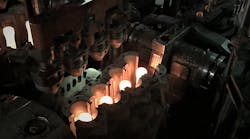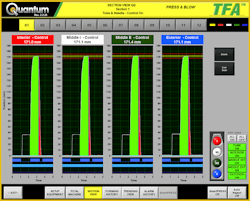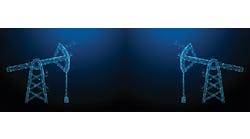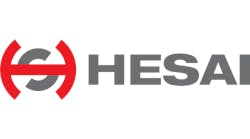No doubt the main attraction and advantage of edge computing is that it's close to the point of production, which means faster data gathering, process monitoring, situation analysis and basic control, as well as fewer network hurdles, less potential latency, simpler programming and lower costs.
"The edge consists of cheaper, faster, better controllers, but they're all enabled by connected devices and cloud computing that lets everyone and their processes be less isolated. Many plants and equipment have always been running at the edge, but they weren't able to communicate," says James Campbell, co-founder at Viewpoint Systems Inc., in Rochester, N.Y., a system integrator and Control Systems Integrators Association (CSIA) member that focuses on measurement for testing applications. "We work with smaller controllers, such as NI Compact RIO and embeddable NI Single-Board RIO from National Instruments, which can collect and analyze large amounts of data next to the machines, such as signal conditions that have key features like maximum pressure, root-mean-square (RMS) vibrations, or proximity of axles to bearings. These sensors generate signals that need to be acquired a very high bandwidths.
"We had one project that consumed a lot of data, about 7.2 megabytes (MB) per second, but most run at about 5 MB per second or less. These are often reciprocating compressors delivering gases, and we monitor them at 10,000 to 100,000 samples per second. This is a lot compared to many PLCs that, even if they have 1,000 channels and sample every 0.1 second, still only generate 40,000 bytes or 40 kBps. The data volumes our users generate are usually too large to send to the cloud and get a good reaction time for decisions, so we aggregate signals into smaller datasets, and provide summaries to reassure managers about operation or can be analyzed in the cloud by machine learning (ML) or artificial intelligence (AI) software."
Making better bottles
This article is part of a series covering edge computing. Read the rest of the series now.
Campbell reports Viewpoint has implemented edge computing for several end users, such as Quantum Engineered Products Inc. in Saxonburg, Pa., which added NI Compact RIO to the plunger mechanisms used in blank-side forming of glass bottles (Figure 1). The firm's engineers realized they could improve their process by sensing and recording plunger positions into the molten-glass gobs in the blank-side mold, identify and diagnose potential hardware problems, and provide real-time feedback to control their process.
Viewpoint developed custom software, Total Forming Analysis (TFA), that runs on NI Compact RIO and serves as a process monitoring and control system for the hot side of the forming process. When position measurements are found to be out of tolerance, TFA communicates with the machine's auto-reject system to ensure that bad bottles are removed. In addition, final plunger positions are used as feedback to allow closed-loop control of glass gob weight, controlling glass feeder tube height and/or needle heights to change gob weights. This allows more precise control of container weights and makes the most efficient use of raw materials while ensuring container quality.
"The old monitoring system at Quantum was DOS-based and ran in real-time, but it wouldn't run Windows and it wasn't deterministic," says Campbell. "We added NI Compact RIO with LabVIEW software next to the machine, and it monitors for problems, and feeds recommendations to the operators."
Likewise, Campbell adds that Viewpoint also recently studied high-speed pressure gauges and injectors inside natural gas-fueled turbines to evaluate their combustion dynamics. "To avoid imbalances, these turbines need fuel to be pushed in uniformly, so injector pressure has to be measured and monitored by 20 sensors using FastFourier Transform (FFT) on the dynamic signals," says Campbell. "Features picked up from the FFT are sent via Modbus to the master PLC, where the tags are analyzed once per second, and instructions are sent back to tune the injectors. This was previously done with slower updates of tens of seconds. In the future, the user will be able use NI Compact RIO to add injector tuning algorithms."
Figure 2: Viewpoint's custom Total Forming Analysis (TFA) software runs on NI Compact RIO, and serves as a process monitoring and control system for the hot side of Quantum's bottle-forming process. When position measurements are found to be out of tolerance, TFA communicates with the machine's auto-reject system to ensure that bad bottles are removed. In addition, final plunger positions are used as feedback to allow closed-loop control of glass gob weight, controlling glass feeder tube height and/or needle heights to change gob weights. This allows more precise control of container weights, and makes the most efficient use of raw materials while ensuring container quality. Source: Viewpoint and Quantum
Securing connections
Because edge devices must connect to servers and cloud-computing services at some point, Campbell adds their users must also follow cybersecurity protocols and consider network bandwidth, too. "Some applications like wind farms generate tens of megabytes per second, so operators have to make certain connections won't be an issue, and that routers and firewalls won't jam. This means they have to get IT involved," says Campbell. "Everyone's concerned about work levels and overtime for implementing and maintaining new systems because they're already busy. Plus, over the past five years, cybersecurity has become increasingly essential, and customers are asking us to prove that our deployments will be secure. However, we can't do it without IT's help.”
"We also work with clients to decide what and how much data should be available to pass around and make available to their IT servers. Users typically want all possible data, but they need to prioritize, and OT and IT must come together to develop a cybersecurity policy that make sure OT's additions will fit into IT's infrastructure. Eight or 10 years ago, IT was concerned about taps and hacks into their servers, in locked rooms, while much of the process equipment was ignored, even outside the building. Now, IT is learning about physical security of OT equipment. They need to talk to OT about that infrastructure and participate in equipment acceptance tests, and develop technical refresh policies for maintaining and updating that infrastructure."







